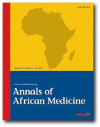
|
Annals of African Medicine
Annals of African Medicine Society
ISSN: 1596-3519
Vol. 6, No. 3, 2007, pp. 89-93
|
 Bioline Code: am07024
Bioline Code: am07024
Full paper language: English
Document type: Research Article
Document available free of charge
|
|
|
Annals of African Medicine, Vol. 6, No. 3, 2007, pp. 89-93
| fr |
Omoti, A. E. & Omoti, C. E.
Résumé
Introduction: La participation ophtalmique dans lymphome est une condition rélativement rare qui peut être provoqué par lymphome intraoculaire primaire ou une manifestation intraoculaire du lymphome systématique. Ce rapport fait une rétrospective des manifestation ophtalmique du lymphome.
Méthodes: Une rétrospective des informations pertinentes des articles dans les journaux et des recherches dans l'internet.
Résultats: Prèsque toutes les structures dans l'orbite, adnexiae et l'oeil peuvent participer dans lymphome. Lymphome de l'oeil et d'adnexiae sont le plus souvent du lignage B. La plupart des manifestations oculaires les plus souvent mascarade comme d'autre conditions intraoculaire plus bénigne y compris des infections conjunctivite ou allergique, uveite, syndrome tacheté du blanc évanescent multiple, nécrose aigue rétine ou rétinite herpetique. Donc diagnostique correcte dépend d'index plus élevé du soupçon et l'imaging radiologique est très fréquemment éxigé, analyse histologique, la biopsie vitreouse en particulier ou bien écoulement cytométrie, aspiration sousrétine et la biopsie rétine. Le diagnostique est souvent rétardé et pourrait aboutir à un résultat sérieux. Réconnaissance de son mode de présentation facilitera un diagnostique précoce et un traitement qui pourrait améliorer la prognose.
Conclusion: C'est très important de faire une rétrospective des manifestations oculaires du lymphome afin d'aider l'ophtamologiste de jouer un rôle clef dans un diagnostique précoce et traitement du lymphome oculaire, et pour aider l'hématologiste et oncologiste de réconnaitre le besoin pour une évaluation ophtalmique dans le diagnostique, des soins post-hospitaliers et la prise en charge des patients atteints du lymphome.
Mots Clés
Lymphome, manifestation ophtalmiques, mascarade, biopsie vitreuse
|
| |
| en |
Ophthalmic Manifestations of Lymphoma
Omoti, A. E. & Omoti, C. E.
Abstract
Background: Ophthalmic involvement in lymphoma is a relatively rare condition that can result from a primary intraocular lymphoma or an intraocular manifestation of systemic lymphoma. This report reviews the ophthalmic manifestations of lymphoma.
Methods: Review of relevant information from journal articles and Internet search.
Results: Almost all the structures in the orbit, adnexiae and eye can be involved in lymphoma. Lymphoma of the eye and adnexiae are most frequently of B lineage. Most of the ocular manifestations frequently masquerade as other more benign intraocular conditions including allergic or infectious conjunctivitis, uveitis, multiple evanescent white dot syndrome, acute retinal necrosis or herpetic retinitis. Correct diagnosis thus depends on a high index of suspicion and frequently requires radiologic imaging, histologic analysis, particularly vitreous biopsy or flow cytometry, subretinal aspiration and retinal biopsy. Diagnosis is often delayed and may lead to a fatal outcome. Recognition of its modes of presentation facilitates early diagnosis and treatment that may improve prognosis.
Conclusions: It is important to review the ocular manifestations of lymphoma to assist the ophthalmologist to play a pivotal role in the prompt diagnosis and treatment of ocular lymphoma, and the haematologist/oncologist to recognize the need for a complete ophthalmic evaluation in the diagnosis, follow-up and management of lymphoma patients.
Keywords
lymphoma, ophthalmic manifestations, masquerade, vitreous biopsy
|
| |
© Copyright 2007 - Annals of African Medicine.
Alternative site location: http://www.annalsafrmed.org
|
|
